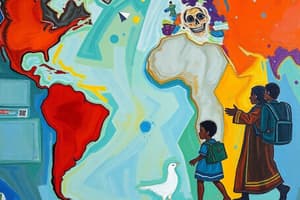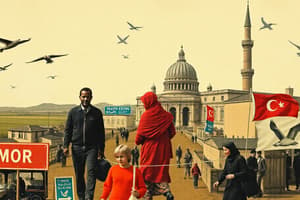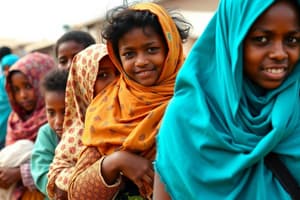Podcast
Questions and Answers
How does the gravity model explain migration patterns?
How does the gravity model explain migration patterns?
- It suggests that closer destinations are more likely to attract migrants than distant destinations. (correct)
- It emphasizes the role of cultural differences in influencing migration flows.
- It predicts that larger cities are more likely to attract migrants than smaller cities. (correct)
- It focuses on the impact of political instability on migration decisions.
Which of the following is a key pull factor for migration to Western Europe from Eastern Europe after the end of Communism?
Which of the following is a key pull factor for migration to Western Europe from Eastern Europe after the end of Communism?
- Greater political freedom and economic opportunities in Western Europe. (correct)
- Increased religious persecution in Eastern Europe.
- A desire for a warmer climate in Western Europe.
- Stricter environmental regulations in Eastern Europe.
What does the term 'brain drain' refer to in the context of migration?
What does the term 'brain drain' refer to in the context of migration?
- The influx of illegal immigrants into a country.
- The loss of skilled workers and professionals from a country due to migration. (correct)
- The movement of people from rural areas to urban areas within a country.
- The decline in birth rates in a country due to increased migration.
Which of the following is NOT a major wave of migration to the United States?
Which of the following is NOT a major wave of migration to the United States?
How did the demographic transition act as a push factor in European migration during the Industrial Revolution?
How did the demographic transition act as a push factor in European migration during the Industrial Revolution?
What was a significant consequence of the large-scale immigration of Irish, Italian, and Polish people to the United States during the 19th century?
What was a significant consequence of the large-scale immigration of Irish, Italian, and Polish people to the United States during the 19th century?
Which of the following is a characteristic of guest workers?
Which of the following is a characteristic of guest workers?
What is the main difference between a refugee and a displaced person?
What is the main difference between a refugee and a displaced person?
What is the key difference between an "intervening obstacle" and an "intervening opportunity" in migration?
What is the key difference between an "intervening obstacle" and an "intervening opportunity" in migration?
What is the primary reason why some countries accuse the United States of "brain drain"?
What is the primary reason why some countries accuse the United States of "brain drain"?
Which of the following is NOT a major wave of global migration?
Which of the following is NOT a major wave of global migration?
What is the main reason why the 1920's quota laws were implemented?
What is the main reason why the 1920's quota laws were implemented?
What is the primary reason for the high level of migration from rural areas to urban areas?
What is the primary reason for the high level of migration from rural areas to urban areas?
What is a major challenge faced by guest workers in their host countries?
What is a major challenge faced by guest workers in their host countries?
Why was the 1986 Immigration Reform and Control Act unsuccessful in its goal of legalizing illegal immigrants?
Why was the 1986 Immigration Reform and Control Act unsuccessful in its goal of legalizing illegal immigrants?
What is "counter-urbanization" and how does it differ from typical rural-to-urban migration?
What is "counter-urbanization" and how does it differ from typical rural-to-urban migration?
What are some typical characteristics of a guest worker?
What are some typical characteristics of a guest worker?
What is the main difference between a push factor and a pull factor in migration?
What is the main difference between a push factor and a pull factor in migration?
Which of the following is NOT one of the major movements in US history?
Which of the following is NOT one of the major movements in US history?
What is the most popular type of migration worldwide?
What is the most popular type of migration worldwide?
Which of the following is a major pull factor for migrants to the sunbelt region of the United States?
Which of the following is a major pull factor for migrants to the sunbelt region of the United States?
In what ways did the end of communism in Eastern Europe act as both a push and a pull factor for migration to Western Europe?
In what ways did the end of communism in Eastern Europe act as both a push and a pull factor for migration to Western Europe?
Flashcards
Migration
Migration
The permanent or semi-permanent relocation of people from one place to another.
Push Factor
Push Factor
A reason that drives people to leave their home country, often negative.
Pull Factor
Pull Factor
A reason that attracts people to a new place, often positive.
Ravenstein’s Laws of Migration
Ravenstein’s Laws of Migration
Signup and view all the flashcards
Types of Movement
Types of Movement
Signup and view all the flashcards
Distance Decay
Distance Decay
Signup and view all the flashcards
Demographic Transition and Migration
Demographic Transition and Migration
Signup and view all the flashcards
Guest Workers
Guest Workers
Signup and view all the flashcards
Chain Migration
Chain Migration
Signup and view all the flashcards
Cyclical Movement
Cyclical Movement
Signup and view all the flashcards
Counter-Urbanization
Counter-Urbanization
Signup and view all the flashcards
Refugees
Refugees
Signup and view all the flashcards
Displaced Persons
Displaced Persons
Signup and view all the flashcards
1920s Quota Laws
1920s Quota Laws
Signup and view all the flashcards
1986 Immigration Reform
1986 Immigration Reform
Signup and view all the flashcards
Brain Drain
Brain Drain
Signup and view all the flashcards
Transhumance
Transhumance
Signup and view all the flashcards
Intervening Obstacles
Intervening Obstacles
Signup and view all the flashcards
Study Notes
Migration Study Guide
- Migration Defined: A permanent change of residence.
- Emigration: Leaving a country.
- Immigration: Entering a country.
- Push Factors: Negative factors driving people away from an area (e.g., poor conditions, war).
- Pull Factors: Positive factors attracting people to an area (e.g., better jobs, opportunities).
- Intervening Obstacles: Barriers preventing migration (e.g., mountains, rivers).
- Intervening Opportunities: Better options encountered during migration that lead to settling elsewhere.
- Refugees: People fleeing a country due to persecution or war.
- Displaced Persons: People forced to leave their homes but remain within their country's borders.
- Guest Workers: Migrants temporarily working in another country, usually with a visa.
- Cyclical Movement: Regular journeys back and forth to a home base.
- Transhumance: Migration with livestock, following seasonal changes in pastureland.
- Step Migration: Migration in stages, moving from smaller to larger settlements.
- Chain Migration: Migrants move from one place to another that follows a family line.
- Periodic Movement: Short-term, repetitive movements away from home.
- Physical Environment: Climate, natural disasters can be push or pull factors.
- Examples of Major Migration Waves/Patterns: Europe to Americas, Africa to Americas (slave trade), UK to Australia, India to South Africa, Eastern US to Western territories, early 1800s: UK, Scandinavia, and Germany; late 1800s: Ireland, Italy, and Poland.
Reasons for Migration
- Economic Factors: Seeking jobs, better pay, economic opportunities.
- Cultural Factors: Seeking a different culture, escaping persecution.
- Political Reasons for Migration: Seeking political asylum, escaping war or conflict.
- Environmental Factors: Natural disasters, climate change, searching for better living conditions.
- Demographic Transition: A push factor in European migration during the Industrial Revolution, as seen in Ireland; a good example of both push and pull factors. (economic hardship in source countries vs. pull of opportunities in destination countries).
- Guest Worker Programs: Workers moving temporarily due to labor demands.
- End of Communism: Served as both a push (forced emigration) and pull (economic opportunities) factor for migration from Eastern Europe to Western Europe.
- Israel (Diaspora to Zionism): a specific case of religious migration and cultural ties.
Impact of Migration
- Demographic Transition Stage: Zelinski's model identifies the second stage as having the highest global migration patterns.
- Brain Drain: Skilled workers leaving a region; a negative effect associated with migration. Possible reasons include better opportunities in another region.
- Cultural Diffusion: Spread of culture and traditions through migration.
- Impact on Source and Destination Countries: Socioeconomic impacts on both regions can include brain drain from source regions, and labor shortages or increases in diversity in destination countries.
Obstacles to Migration
- Physical Barriers: Mountains, oceans, deserts.
- Legal Restrictions: Visas, immigration policies.
- Economic Barriers: Lack of resources, money.
- Social/Cultural Barriers: Language barriers, prejudice.
- Government Policies: Laws/regulations influencing migration.
Migration within Countries
- Rural to Urban Migration: People moving from rural to urban areas.
- Counter-Urbanization: People moving from urban to rural communities.
- Internal Migration Patterns: Examples: Westward Expansion, Trail of Tears, Great Migration, Sun Belt migration.
Studying That Suits You
Use AI to generate personalized quizzes and flashcards to suit your learning preferences.




